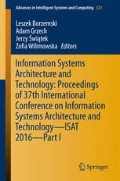Abstract
The paper presents a new multi-dimensional Erlang’s Ideal Grading (EIG) model with queues and priority that can service a number of call classes with differentiated access to resources. The model was used to determine delays and packet loss probabilities in the wireless access system. The analytical results obtained in the study were then compared with the results of a simulation, which confirmed the essential and required accuracy of the proposed model. The model developed in the study can be used to analyse, design and optimize present-day wireless access system.
Access this chapter
Tax calculation will be finalised at checkout
Purchases are for personal use only
References
Yin, Z., Yu, F., BU, S., Han, Z.: Joint cloud and wireless networks operations in mobile cloud computing environments with telecom operator cloud. IEEE Trans. Wireless Commun. 99, 1–1 (2015)
Martignon, F., Paris, S., Filippini, I., Chen, L., Capone, A.: Efficient and truthful bandwidth allocation in wireless mesh community networks. IEEE/ACM Trans. Netw. 23(1), 161–174 (2015)
Wikisource: Telecommunications act of 1996. http://en.wikisource.org (2009) (Online)
Stasiak, M., Hanczewski, S.: Approximation for multi-service systems with reservation by systems with limited-availability. In: Computer Performance Engineering, LNCS, vol. 5261, pp. 257–267. Springer (2008)
Stasiak, M., Głąbowski, M., Hanczewski, S.: The application of the Erlang’s Ideal Grading for modelling of UMTS cells. In: 8th International Symposium on Communication Systems, Networks Digital Signal Processing (CSNDSP), July 2012, pp. 1–6
Hanczewski, S., Stasiak, M., Zwierzykowski, P.: Modelling of the access part of a multi-service mobile network with service priorities. EURASIP J. Wireless Commun. Netw. 2015(1), 1–14 (2015)
Brockmeyer, E.: A survey of A.K. Erlang’s mathematical works. Danish Acad. Tech. Sci. 2, 101–126 (1948)
Lotze, A.: History and development of grading theory. In: Proceedings of 5th International Teletraffic Congress, pp. 148–161 (1967)
Brockmeyer, E., Halstrom, H., Jensen, A.: The life and works of A.K. Erlang. Acta Polytechnika Scandinavia 6, 287 (1960)
Thierer, M.: Delay System with Limited Accessibility. In Prebook of the 5th International Teletraffic Congress, 1967, pp. 203–213
Thierer, M.: Delay system with limited availability and constant holding time. In: Prebook of the 6th International Teletraffic Congress, Munich, pp. 322/1–322/6 (1970)
Gambe, E.: A study on the efficiency of graded multiple delay systems through artificial traffic trials. In: Proceedings of 3rd International Teletraffic Congress, Paris, doc. 16 (1961)
Kühn, P. (1970) Combined delay and loss systems with several input queues, full and limited accessibility. In: Proceedings of 6th International Teletraffic Congress, Munich, pp. 323/1–7 (1970)
Kühn, P.: Waiting time distributions in multi-queue delay systems with gradings. In: Proceedings of 7th International Teletraffic Congress, Stockholm, pp. 53–61 (1973)
Kampe, G., Kühn, P.: Graded systems with infinite or finite source traffic and exponential or constant holding time. In: Proceedings of 8th International Teletraffic Congress, Melbourne, pp. 251/1–10 (1976)
Stasiak, M.: An approximate model of a switching network carrying mixture of different multichannel traffic streams. IEEE Trans. Commun. 41(6), 836–840 (1993)
Hanczewski, S., Stasiak, M.: Performance modelling of Video-on-Demand systems. In: 17th Asia-Pacific Conference on Communications (APCC), pp. 784–788 (2011)
Głąbowski, M., Hanczewski, S., Stasiak, M.: Erlang’s Ideal Grading in Diffserv modelling. In: AFRICON, 2011, pp. 1–6 (2011)
Głąbowski, M., Hanczewski, S., Stasiak, M.: Modelling of Cellular Networks with Traffic Overflow. Mathematical Problems in Engineering, Article ID 286490 (2015)
Hanczewski, S., Stasiak, M., Weissenberg, J., Zwierzykowski, P.: Queuing model of the access system in the packet network. In: Computer Networks, ser. Communications in Computer and Information Science. Springer, vol. accepted for publication (2016)
Katzschner, L., Scheller, R.: Probability of loss of data traffics with different bit rates hunting one common PCM-channel, pp. 525/1–8 (1976)
Stasiak, M., Wiewióra, J., Zwierzykowski, P., Parniewicz, D.: An approximate model of the WCDMA interface servicing a mixture of multi-rate traffic streams with priorities. In: Thomas, N., Juiz, C. (eds.) 5th European Performance Engineering Workshop, vol. 5261, pp. 168–180 (2008)
Głąbowski, M., Hanczewski, S., Stasiak, M., Weissenberg, J.: Modeling Erlang’s Ideal Grading with Multirate BPP traffic. Mathematical Problems in Engineering, Article ID 456910 (2012)
Roberts, J. (ed.): Performance evaluation and design of multiservice networks. Final Report COST 224. Commission of the European Communities, Brussels (1992)
Little, J.: A proof for the queueing formula: L = w. Oper. Res. 9(3), 383–387 (1961)
Chydziński, A., Adamczyk, B.: Analysis of a scheduler for virtualization of links with performance isolation. Appl. Math. Inf. Sci. 8(6), 2653–2666 (2014)
Chydziński, A.: Delay analysis for an AQM queue with dropping function. In: Proceedings of the 11th WSEAS International Conference on Data Networks, Communications and Computers. World Scientific and Engineering Academy and Society, September 2012, pp. 53–57
Domański, A., Domańska, J., Czachórski, T.: Comparison of aqm control systems with the use of fluid flow approximation. In: Computer Networks, ser. Communications in Computer and Information Science, vol. 291, pp. 82–90. Springer (2012)
Author information
Authors and Affiliations
Corresponding author
Editor information
Editors and Affiliations
Rights and permissions
Copyright information
© 2017 Springer International Publishing AG
About this paper
Cite this paper
Hanczewski, S., Stasiak, M., Zwierzykowski, P. (2017). Queuing Model of Wireless Access System. In: Borzemski, L., Grzech, A., Świątek, J., Wilimowska, Z. (eds) Information Systems Architecture and Technology: Proceedings of 37th International Conference on Information Systems Architecture and Technology – ISAT 2016 – Part I. Advances in Intelligent Systems and Computing, vol 521. Springer, Cham. https://doi.org/10.1007/978-3-319-46583-8_14
Download citation
DOI: https://doi.org/10.1007/978-3-319-46583-8_14
Published:
Publisher Name: Springer, Cham
Print ISBN: 978-3-319-46582-1
Online ISBN: 978-3-319-46583-8
eBook Packages: EngineeringEngineering (R0)

